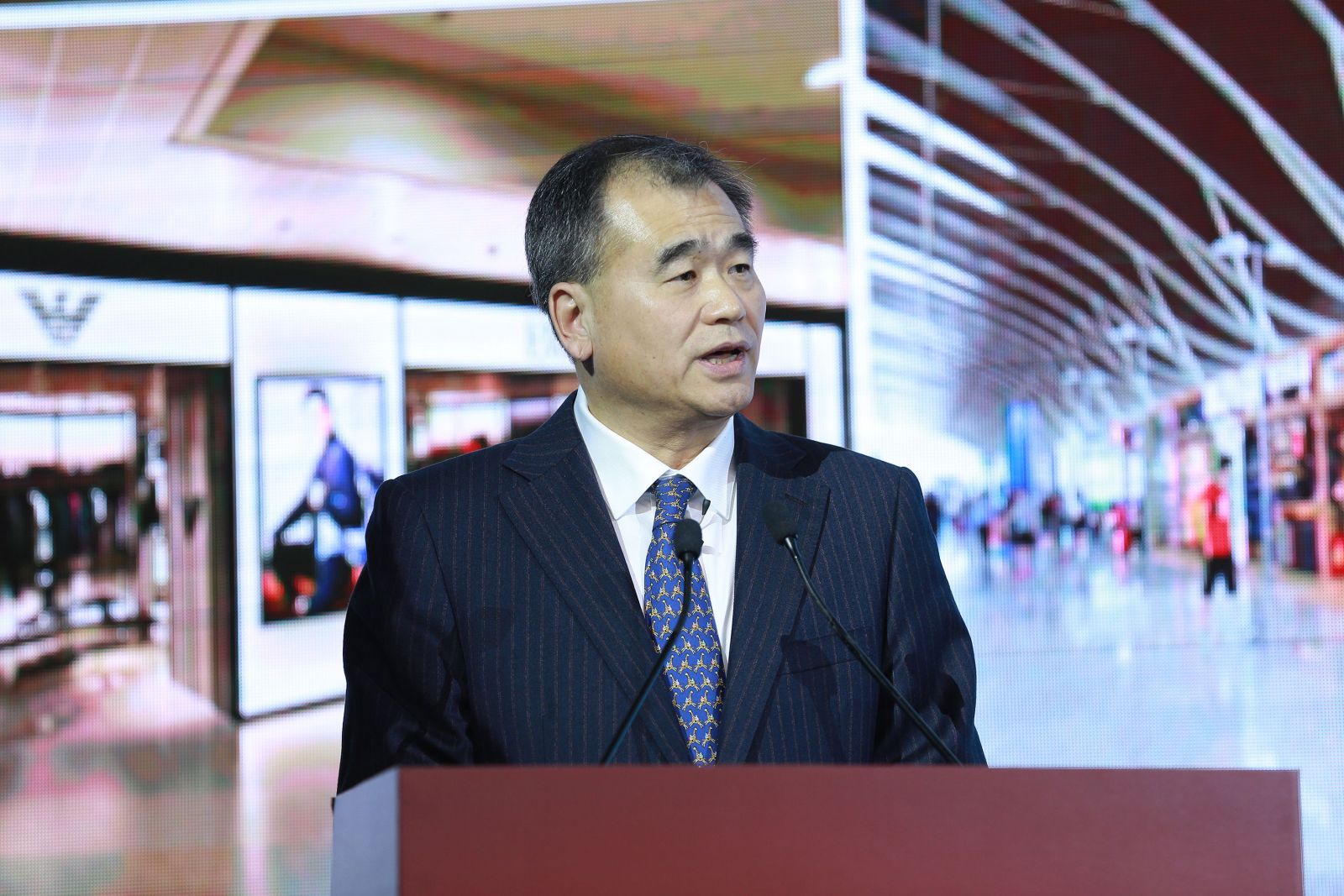Destination 2030: The next steps on the travel retail journey
Two airport companies and a leading luxury brand took up the challenge of predicting the factors that will drive the industry forward in the next decade and beyond.
Digitalisation, new travel dynamics, and points of difference: these were among the themes discussed by a panel that brought together Shanghai Airport Authority Vice President Ruijun Jia, Japan Airport Terminal Company Executive Vice President and Chief Operations Director Hiroshi Onishi, and Furla Global Travel Retail Director Gerry Munday.

An outstanding panel brought together (from left) moderator Dermot Davitt; Shanghai Airport Authority Vice President Ruijun Jia; Furla Global Travel Retail Director Gerry Munday; and Japan Airport Terminal Company Executive Vice President and Chief Operations Director Hiroshi Onishi.
Ruijun Jia considered how disruptors were affecting the industry and shared Shanghai Airport Authority’s plans to address these changes to remain relevant.
“Shanghai Airport Authority (SAA) will seize the opportunity of smart airport construction and revolutionise the consumption model to ensure growth and to improve the level of service,” he said. “We will use big data and a broader partnership strategy to capture the development opportunities and challenges of the travel retail industry.”
The new generation of passengers, he continued, necessitates a “revolution” of the sales model. “The function of future airport stores will change from mostly sales to both sales and experience. On-site sales will certainly maintain a significant proportion, as the on-site shopping experience is pleasant. With online product display and offline sales tactics that emphasise experience delivery and logistics solutions, a value-added shopping experience can be delivered.”

Jia said that the format and brand mix for travel retail will become more individualised, culture-focused and diversified. “In recent years, affordable luxury brands, designer brands and local cultural brands have been frequently introduced into the airport.
“Technologies including digitalisation, automation and bio information will be widely used. It is foreseeable that more and more passengers will use their smart devices such as mobile phones to control their check-in procedures. Simplifying the boarding procedure will allow passengers to spend more time on shopping.
“The application of new technologies not only helps the airport to monitor real-time operation status, but also helps to better deploy staff and to understand more of the consumer behaviours and shopping preferences so that the retail and catering offer can be optimised.” Data, he added, is key to understanding the customer and encouraging consumption.
Jia stressed the importance of “strategic partnerships” to the future of travel retail. “Collaboration offers mutual benefit,” he said. “Carry out broader strategic cooperation and you can establish a new and more dynamic travel retail business benchmark.”
“We will use big data and a broader partnership strategy to capture the development opportunities and challenges of the travel retail industry.”
- Shanghai Airport Authority Vice President Ruijun Jia
Hiroshi Onishi argued for significant changes to the structure and presentation of retail categories at airports, and also highlighted the benefits of adding a strong sense of the local.
“The airport terminal building is like a large-scale shopping centre that also functions as a town,” he said. “We need to consider at length who our target consumer is and what they really want and need, and we must change the airport offer to meet that.”
Retail, F&B and leisure can work together he said, noting that the current separation will not work for the future. Rather than the current categories of “luxuries, cosmetics, food, and clothing”, he said, the future will instead look at “health, experience, culture, and art”.
“What will be important in the future,” Onishi noted, “is that [the airport] should be a place where people can have an experience; not a pass point but a gathering point.”
The market is changing, he said, and this is posing a number of questions for our industry. As mass-produced low-cost models wane, how should we react as retail operators? How can we recoup the necessary investment into the digital? As “virtual consumption” increases, what will be the role of physical stores?
Retail offers, he said, need to be more carefully curated and offer more options for customisation and even completely personalised products. New technology such as bodyscanning and 3D printing will make this possible.

Onishi considered the significance of the “rise of virtual consumption” and the difference between purchase decisions made in store and online. Online, he said, customers are targeted, using search engines and taking an analytical approach to the decision. In store, we need to convince the customer.
He then explained that Japan Airport Terminal Company has started to capitalise on the modern shopper’s desire for the local. Today’s traveller, he said, collects experiences. They want to discover local culture. In reaction to this, he said, retail offerings need to change, comprising local products. Tokyo Haneda Airport, for example, is incorporating products made from local fabrics and by local labels.
“Our mission is to introduce Japanese unique products to foreigners. We will make the airport a base for art and culture,” he said.
“The airport should be a place where people can have an experience; not a pass point but a gathering point.”
- Japan Airport Terminal Company Executive Vice President and Chief Operations Director Hiroshi Onishi

“The world will be a very different place in just 12 years time,” stated Furla Global Travel Retail Director Gerry Munday. “By 2030, we can estimate almost 8 billion passengers. And all of those are additional potential shoppers.
“Will global travel retail still be a showcase for brands in 2030 or – thanks to digital advances – will consumers be browsing and shopping a showcase of brands from their homes, viewing the airport as simply a place from which to travel?” she asked.
For Munday, “successful brands will be those who use predictive analytics to tailor their offerings to customers”.
However, she said, other factors are at play. “A crucial element of success,” she added, “is changing the lease structures between landlord and retailer/brand. Lease structures that are typically dependent on percentage or turnover rent will need to be restructured as the methods of measuring store performance shift.”
Echoing Ruijun Jia, Munday said: “The role of the store is changing, becoming less a place for transactions and more for experiences and emotional connections. Brands will be able to define the true value of the store – through data – not just on traditional in store sales but also by items bought online and collected in store and by online sales which have been influenced by the store.”
Domestically, she said, we can assume lease terms will be much more flexible and set up costs will be lower. But, she asked: “Will the same be true of airports? Will the airport-retailer-brand concession structure similarly change? I believe it has to if we are to survive.”

“We need to nurture our image as an industry where the retail experience is truly different, offering more exclusives and better experiential retail with real Sense of Place.”
- Furla Global Travel Retail Director Gerry Munday
Munday argued that the increase in passenger numbers gave airport retail a strong advantage over domestic channels and “a guaranteed potential audience”. However, she said, the industry needs to work on turning the potential into reality.
“What we do know is that experience seduces consumers. Key to success in 2030 will be enabling consumers to buy what they want, where, and how they want, instantly,” continued Munday. “The product mix available in airports will have to change – and, I’ve been asking for years whether we’re offering consumers the right product mix now.
“With Millennials and increasingly Generation Z, if we are to have their loyalty, shouldn’t we be ensuring that we’re offering them products they want and are interested in now? Ask a 19-22 year old about fashion and they cite ‘athleisure’ brands like Adidas, Vans, Dickies, Supreme and Champion. How many of those are in airport retail?
“Generation Z (born between 1995-2009) are into being unique – vintage, one-offs; they want to save the world and they’re the reason why veganism is rapidly on the rise. They’ve been brought up with everything digital – it’s part of their lives – but according to recent surveys conducted by Google, Accenture and Shoppercentric, Gen Z will use devices to help choose products but the majority prefer to visit stores to make the final purchase. They want the real life experience.
“Generation Z represents the largest consumer base through to 2030. They will shape the way businesses create and market their products tomorrow.

“They have ushered in massive cultural shifts, not least in attitudes towards gender and sexuality. Brands that accomplish Gen Z’s expectations for authenticity, diversity, technology and social equality will win.”
For Munday, the key to capturing the contemporary consumer is to communicate with them before they travel and to better use data analytics to target them.
“By 2030 consumers will be living in a daily experiential world where through the power of predictive data they can buy anything at any time; where facial recognition ads at every corner suggest they need a coffee, or a snack bar, or to buy a warm scarf for the chilly week ahead (with same day delivery).
“We need to be delivering the same – or a better – experience in airports.”
She argued: “We need to nurture our image as an industry where the retail experience is truly different, offering more exclusives and better experiential retail with real Sense of Place. A value proposition beyond traditional high duty products at duty free prices. We need to make sure technology is on our side and not working against us.
“Importantly, we need to cater for everyone travelling – all ages, all nationalities with deep or not so deep pockets. It’s not all about luxury.”

The Moodie Davitt e-Zine | Issue 252 | 16 November 2018